
09.11.2017
by Michaela Bathrick, Los Angeles, California, USA
September 13, 2017 – December 17, 2017
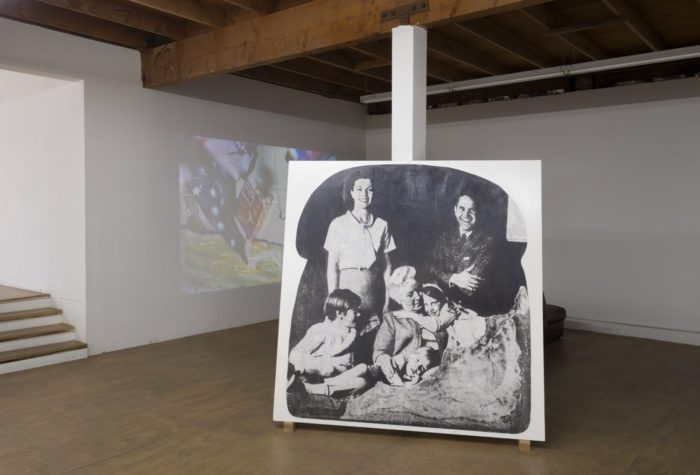
The Getty’s Pacific Standard Time: LA/LA is charged with revisiting, if not revising, history through art. A huge number of the exhibitions which collectively make up PST are invested in giving due attention to artists and movements which have been left out of the western art narrative. Two such artists are León Ferrari, with work at REDCAT, and Juan José Gurrola at House of Gaga. Both posthumous shows deal in the re-writing of histories themselves, confronting authorities with dark humor and conceptual tact.
The Words of Others: León Ferrari and Rhetoric in Times of War opens like a labyrinth. Plywood walls direct viewers through a maze of diagrams crowded with letters, books, projected images, video and collage. The show is a powerful introduction for many Angelenos to the work of the Argentine artist; it’s one of the most significant solo shows Ferrari has had in the United States. The exhibition takes its title from one so-called “literary collage.” Palabras Ajenas, or The Words of Others, is a script Ferrari published in 1967 in response to the senselessness of the Vietnam War. Using quotes from a variety of sources the publication forces a dada-esque dialogue between characters such as Presidents Johnson and Truman, the media, Hitler, Jesus, and the Pope. Performed for the first time in its entirety by Los Angeles artists in 2017, the resulting audio is a surprisingly entertaining conversation both absurdist and poignant.

Palabras Ajenas, deals directly with the challenge of representing oppression, namely United States’ imperialism. In representing authoritarian government through visual art many fall into the trappings of revealing oppression without critique. Afterall what can more acutely represent oppressive government than such a government itself? As much as Palabras Ajenas is a brazen critique of US policy its success is bound to the fact that it does more than simply criticize. It uses the language of authority to demand its viewers consider the very nature of hegemony. Such critiques of power structures are pertinent in our oft-mentioned “current climate”. With the rise of open nationalism, imperialism and racism in the United States, and globally, it is difficult to find representation that communicates with more gravity than such “isms” already do. Who can make a more convincing argument that President Trump is an egotistical racist than the one he does himself? Ferrari’s Palabras Ajenas walks the difficult line of creating critique using its bonds as weapons. In making the literal words of the authorities even more absurd through performative drama, Ferrari further exposes the US government’s imperialist methodology.
Simultaneously the artist examines how the delivery of information can be used to communicate a concept of truth or manipulated to create alternative truths (insert the exhausted “fake news” here). These critiques are poetically explored in the small collage Swish and Swallow (1964). A clipping of a newspaper ad declares in English “Swish And Swallow” before continuing in Spanish to advertise a mouthwash that can be swallowed. Framing the clipping is hand-written in an elongated, inky cursive which repeats the ad’s text. The doubling creates dual meanings even between the two repetitive texts; swish and swallow. Beside the collage the wall text notifies viewers of the significance of material in the artist’s career as an early use of newspaper.
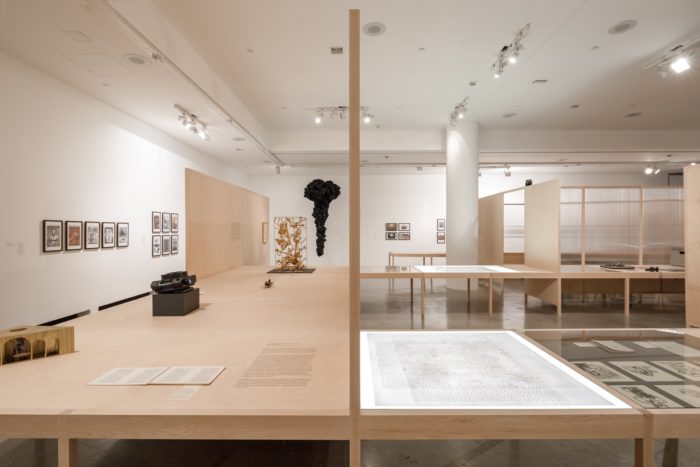
However, the larger significance seems to be that the artist has found a way to gracefully demonstrate the disparity in meaning when words arrive from different sources. Of course Ferrari’s criticism of language goes beyond simple examination of text. Rather he uses the language as a medium to critique war rhetoric and the rhetoric of any number of authorities. His view of the subjugated body is not as victim of a single (U.S.) military, government or religion. Instead it is the amalgamation of such powers that create a unique oppression. To exemplify this he quite literally puts the collective cultural authorities into conversation. Similarly, the show claims that the victims of war are not solely those against whom violence is committed. War inhibits the ability to be critical of authority, and war rhetoric, as an inherent part of the machine of war, mediates the understanding of systematic violence, casting it as simply part of a bureaucratic norm. By confusing the message Ferrari critiques the means.
Mexican artist Juan José Gurrola’s solo show is similarly historicized, however, its angle is less directly political. Gurrola deals in the ostracization from art histories, inserting himself with both playful and aggressive methods. Viewers are introduced to the artist’s practice by three large canvases with transfer dyed images of white 50’s era families framed by extra large toast and kool-aid forms. These works are part of his Dom Art movement. Gurrola’s “dom” is an abbreviation from “domestic,” a word that references both the homestead and the insular country as concept; the artist’s practice examines both.
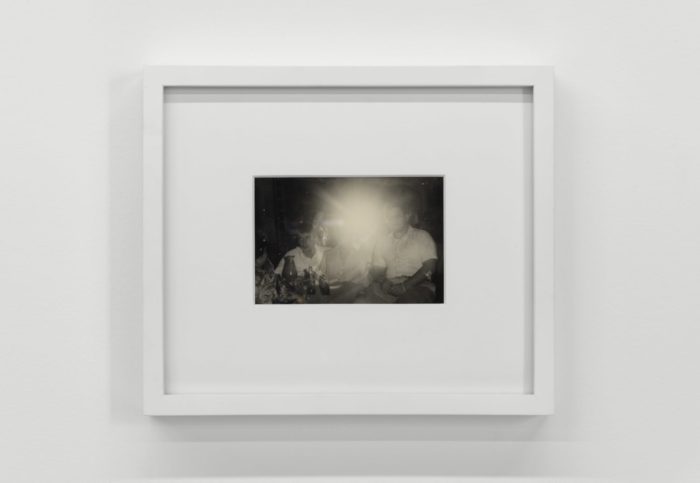
Included in Dom Art are a number of functional recipes created by the artist. Postre de Pollo o Puerco is a recipe for a chicken or pork pot pie with the notable addition of a Cambell’s soup can poured atop. This obvious Warhol reference seems both to connote a reverence for the American artist as well as defiance: is imbibing the soup a Eucharist or sacrilege to the art object that is the soup can?
A parallel duality is found in the Gurrola’s Monoblock series from 1971. It consists of twelve black and white photos of an auto part in different urban locations. Due to trade regulations the object, part of a motor, is the car’s single part which was required to be manufactured in the United States, the rest was fabricated in Mexico. Below the photos the motor part itself is displayed in an industrial refrigeration unit, the kind normally used to display cakes or meat. The heavy-handed metaphor, about the reliance on the U.S. for mobility, is complicated by the method of display. The cult of the object is rendered ridiculous through such blatant repetition and its eventual consumption as the monoblock turns to food in its refrigerator.
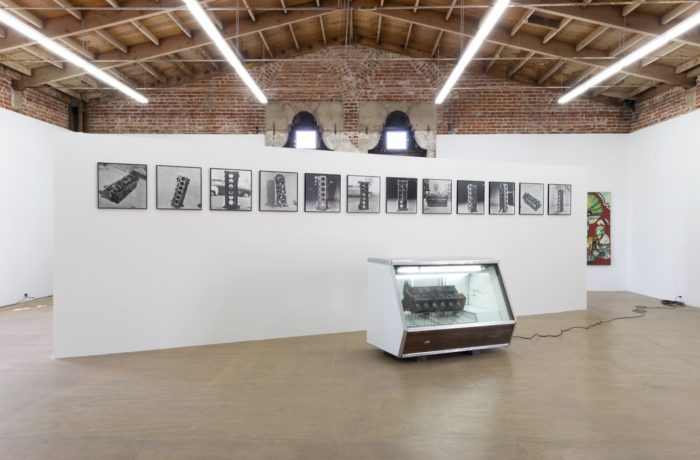
Neither Ferrari nor Gurrola’s relationship to power is static, but the two differ in how they identify authority. Some of Ferrari’s more enjoyable collages are from the series Relecturas de la Biblia, (Rereadings of the Bible) from 1980-2012. Kama Sutra lovers are caught in the act by pasted in angels and saints who fly overhead. Some scold or lecture while others stab at the couple with gold encrusted spears. Such iconoclastic religious iconography appears repeatedly in The Words of Others. In another collage-type, Juicio Final (Last Judgement), from 1985, a photo of Michelangelo’s Last Judgment is adorned with bird excrement, blatantly mocking the church and art history simultaneously. Ferrari uses the influence of such images to ridicule the institutions they represent. In that sense the power of the institutions is what brings weight to the work, complicating the seemingly blunt critique.
Gurrola approaches Documenta 5 with a comparable method. In 1972 the artist directed a short film titled Róbate el Arte, (Steal the Art), in which he attempts, or appears to attempt, to steal a work of art from Documenta. By doing so he refutes the absolute authority of the institution and places himself in a position of curator via subtraction. Here Gurrola’s mentality differs from Ferrari’s as the film’s narrative locates the artist within Documenta 5. Whereas Ferrari’s practice is one of demolition through language, Gurrola’s is of forced inclusion; he desires to be embraced by the art canon and included in Documenta even while he rejects it.
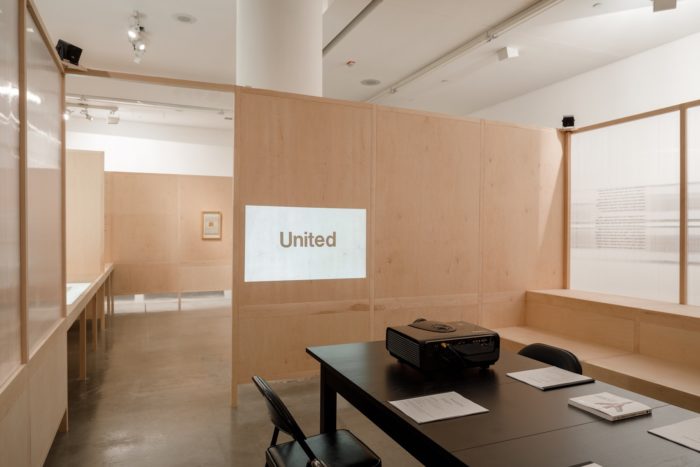
Robate el Arte is also reflective of another side of Gurrola’s practice: the performative. Like Ferarri’s Palabras Ajenas, which uses drama as a method of ridiculing established norms, Gurrola performs schizophrenically, simultaneously paying homage and loudly deprecating artists and institutions. This methodology is apparent in a series of paintings on the back facing wall at Gaga. The three canvases depict visceral bodies and hairy head shaped lumps painted in artist Philip Guston’s thick brusque hand. The paintings are so similar in style to Guston’s they border on imitation. Again the question becomes how one can represent without reproducing. This is seemingly answered by a fourth painting. Although certain painterly marks and muddy tone remain reminiscent of Guston, the imagery and composition of México, ombligo del mundo (Mexico, Belly Button of The World) from 1981 is notably different. The collage of images that make up the painting–a house, a figure bound with rope, a cartoonish and dark guinea pig, an absurd “belly button” or the compass by which to locate the artist both geographically and historically– takes influence from Guston without needing his hand to lend legitimacy. A silhouetted skull adorned with neon feathers punctuates the painting, which eyeballs the viewer and laughs.
Both exhibitions are important for the provocation that they make visible, where the archive and works–even 3 decades after its creation–have validity and social criticism that has not lost its freshness.
Comments
There are no coments available.